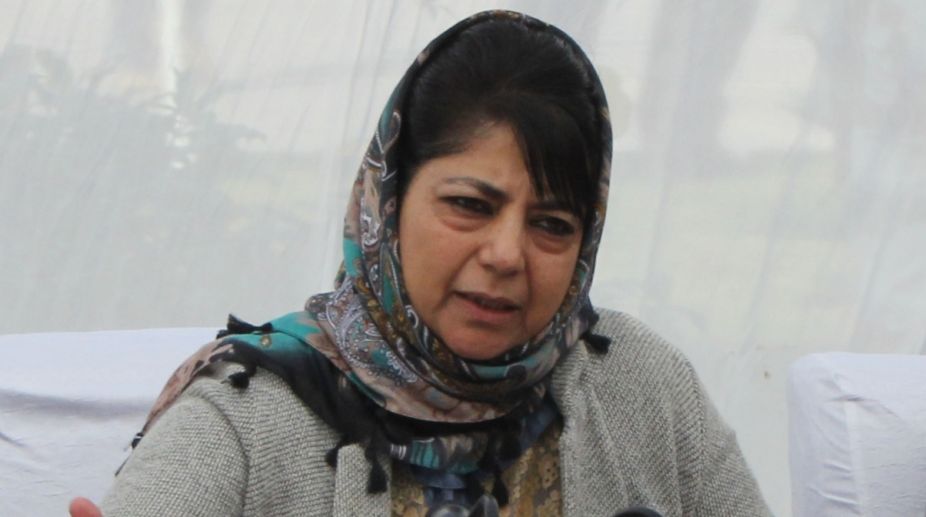AAP councilors protest against cancellation of mayoral polls
The party may move the court after taking legal opinion on the matter, said AAP leader Durgesh Pathak.

Mehbooba Mufti (Photo: IANS/File)
It was not a surprise that the Mehbooba Mufti government in Jammu and Kashmir fell this week; it was a wonder that it lasted this long. She was the unlucky 13th chief minister of the state. The BJP’s dreams of ruling the state as a coalition partner were dashed as it found it impossible to continue in the coalition.
The BJP has had partnerships with almost all political parties except the Congress, the Left parties, AAP and MIM. As for Mehbooba, it was a razor’s edge situation since she took over in April 2015 and it was becoming increasingly untenable. However, while every one knows that the alliance had to break sooner rather than later, no one expected it to happen at this point of time.
Why could not Mehbooba deliver results? Kashmir experts feel the task was beyond her for various reasons and the major one was that this was the first time the PDP had partnered the BJP in an unnatural coalition. Though it was the saffron party which pulled out on Tuesday citing increased terrorist violence, it must have been clear to her that her government was going nowhere.
Advertisement
The BJP blamed the PDP for failing to improve security conditions in the Kashmir Valley. It cited the recent killing of Kashmiri editor Shujaat Bukhari and the abduction and killing of an army jawan while he was going home on Eid leave. Also the BJP, concerned with the 2019 Lok Sabha election, fears that Jammu might slip out of the party’s hands.
Had Mehbooba been clever, she would have forestalled her government’s fall by dumping the BJP first. She could have quit on Sunday when the ceasefire was revoked and become politically stronger in the valley. But she did not have the political acumen of her late father Mufti Mohammed Sayeed, who called the alliance as North Pole and South Pole coming together. He assured the people of Kashmir that the coalition would deliver on its promises, listed out in a document called “The Agenda of Alliance”. Perhaps he might have managed the coalition better.
However, things went from bad to worse after the Mufti’s death on 7 January 2016, and the government formed under Mehbooba was fragile right from the beginning. Due to political compulsions both parties decided to continue the coalition. The BJP leaders did not have the same confidence in her as they had in her father. Mehbooba was not able to govern, as she had to fight at multiple levels for her political survival, including that she was a woman.
She had to face the anger of the people for poor governance, the Kathua rape, lack of infrastructure and development, continued military presence and civilian deaths. Moreover, as the former chief minister Omar Abdullah tweeted “@Mehbooba Mufti’s biggest & least talked about failure has been the massive jump in the numbers of young Kashmiri men joining the ranks of militant organizations.”
Secondly, BJP-PDP workers were not united though the top leadership had favored the coalition. The PDP has a voter base comprising of hardliners in the valley and they resented the alliance with the BJP. Similarly, the BJP workers in Jammu too were unable to explain the partnership with the result there was no coordination at the worker level.
Thirdly, leaders of the two parties were working at cross-purposes. While Mehboobha had been talking about a soft line towards separatists and resumption of dialogue with Pakistan, the BJP-led Centre had other ideas with the result the Kashmir policy was going nowhere. When she invited separatists for talks as the chief of the PDP, they rejected it outright insisting that unless their demands were met there was no meeting point.
The Centre, on the other hand, saw the PDP as an obstruction in carrying out anti-terror operations. Terror outfits like the LeT, JeM and Hizbul Mujahedeen used the recent Ramzan ceasefire to regroup just when the security forces had them on the run.
Fourthly, apart from a package for Kashmiri Pandits who fled from the valley in the 1990s – and another for refugees from Pakistan-administered Kashmir – other issues in the ‘Agenda of alliance’ have not been implemented. Among other promises in the agenda was the one to engage Pakistan and separatist leaders in a peace process for a permanent solution to the vexed Kashmir issue.
Fifthly, by playing second fiddle, the PDP lost out in the valley allowing itself to be outfoxed by the BJP. There was a clear divide in the cabinet. The collapse of the coalition was only waiting to happen in the aftermath of the Ramzan ceasefire and the murder of editor Bukhari.
The failure of the PDP-BJP coalition must be a lesson for future opportunistic alliances. But political parties keep their options open forgetting to learn such lessons. The Kashmir experiment was also different because this is a state where three generations of youth had lost their childhood. Governor’s rule may be a temporary solution but what the state is crying for is a political solution, which has been eluding it for so long.
Advertisement